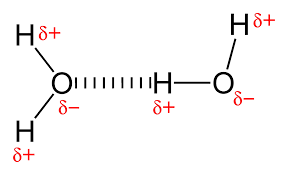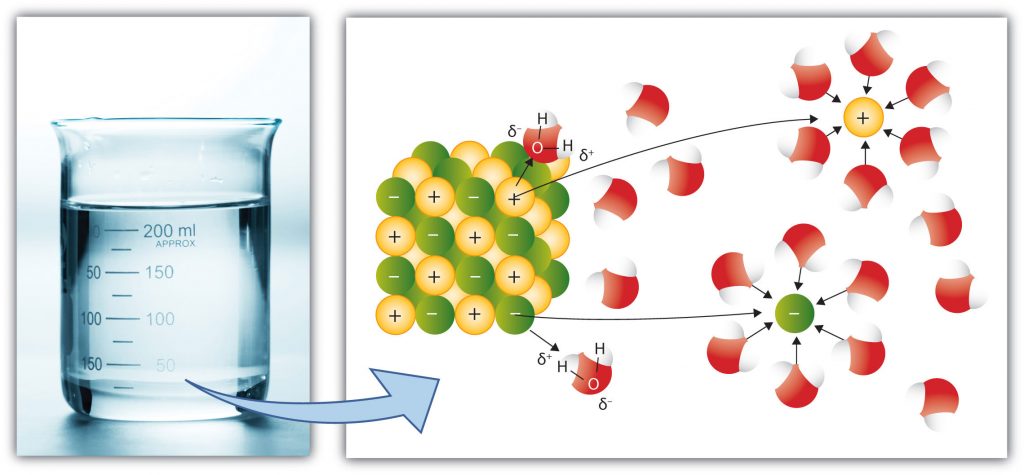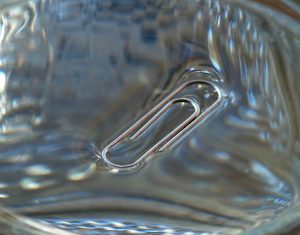Contents
Water
Water
Water is a dipolar molecule, meaning it has an unevenly distributed charge due to the fact that the oxygen atom is slightly negative, and the hydrogen atoms are slightly positive. The delta (δ) symbol indicates slightly positive/negative on the diagram below.
Hydrogen bonds form between different water molecules between the oxygen and a hydrogen atom.
The formation of these hydrogen bonds and the fact that water is dipolar result in 5 key properties of water.
Key Properties of Water
- It is a metabolite (e.g. in condensation and hydrolysis reactions).
- An important solvent in reactions.
- Has a high heat capacity, which buffers temperature.
- Has a large latent heat of vaporisation, providing a cooling effect with loss of water through evaporation.
- Has strong cohesion between water molecules; this supports water columns and provides surface tension.
Metabolite
Water is involved in many reactions, such as photosynthesis, hydrolysis, and condensation reactions.
This is one reason why it is essential that approximately 90% of the plasma in blood is water and the cytoplasm in cells is largely composed of water.
Solvent
Water is a good solvent, meaning many substances dissolve in it. Polar or charged molecules dissolve readily in water due to the fact that water is dipolar. As can be seen in the diagram below, the slight positive charge on hydrogen atoms will attract any negative solutes, and the slight negative charge on the oxygen atoms of water will attract any positive ions in solutes. These polar molecules are often described as hydrophilic, meaning they are attracted to water.
Non-polar molecules, such as lipids, cannot dissolve in water and are therefore described as hydrophobic - they are repelled by water. The fact that so many essential polar substances dissolve in water enables them to be transported easily around animals and plants, either in the blood or xylem.
High Specific Heat Capacity
This means that a lot of energy is required to raise the temperature of water. This is because some of the heat energy is used to break the hydrogen bonds between water molecules. This is useful to organisms as it means the temperature of water remains relatively stable, even if the surrounding temperature fluctuates significantly. Therefore, internal temperatures of plants and animals should remain relatively constant despite the outside temperature, due to the fact that a large proportion of the organism is water. This provides a stable temperature for enzymes to work optimally. Finally, a stable temperature also provides a stable environment for aquatic organisms.
Large Latent Heat of Vaporisation
This means that a lot of energy is required to convert water in its liquid state to a gaseous state. This is again due to the hydrogen bonds between water molecules, as some energy is used to break the hydrogen bonds to turn it into a gas.
This is advantageous to organisms as it means that water provides a significant cooling effect. For example, when humans sweat, they release water onto their skin. Large amounts of heat energy from the skin are transferred to the water to evaporate it, and therefore removing a lot of heat and cooling the organism.
Strong Cohesion
Cohesion is the term used to describe water molecules 'sticking' together by hydrogen bonds. Due to water molecules sticking together, when water moves up the xylem in plants due to transpiration, it is as a continuous column of water. This is advantageous as it is easier to draw up a column rather than individual molecules.
Cohesion also provides surface tension to water. This enables small invertebrates to move and live on the surface, providing them a habitat away from predators within water. You can test this idea of surface tension by carefully placing a paperclip on water, and it should float!
Each of these properties provides an advantage to survival, and they are all due to either the dipolar nature of water or the fact that hydrogen bonds form between molecules.
- How are oxygen and hydrogen held together within a water molecule? (Hint: See images above)
- covalent
- How are water molecules held together?
- Your answer should include: hydrogen / bonds
- Water has an uneven distribution of electrical charges. What is the term given to describe this structural feature?
- dipolar
- Which structural feature of water makes it a good solvent?
- dipolar
- Which structural feature of water provides strong cohesion, a high latent heat of vaporisation, and a high specific heat capacity?
- Your answer should include: hydrogen / bonds





